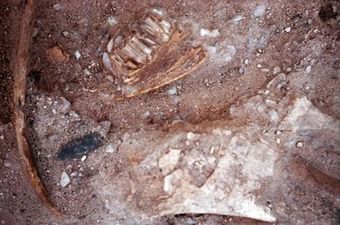Lehner Mammoth-Kill Site facts for kids
|
Lehner Mammoth-Kill Site
|
|

Clovis point in situ near a bison mandible and mammoth bone at the Lehner site, 1955. Higher-resolution photo linked at source.
|
|
| Nearest city | Hereford, Arizona |
|---|---|
| Website | Lehner Mammoth-Kill Site |
| NRHP reference No. | 67000002 |
Quick facts for kids Significant dates |
|
| Added to NRHP | May 28, 1967 |
| Designated NHL | May 28, 1967 |
The Lehner Mammoth-Kill Site is a really important place in southern Arizona. It's famous because it shows us that ancient people, called Paleo-Indians, hunted and killed huge mammoths here about 11,000 years ago (around 9000 BCE). This site helps us understand what life was like for early humans in North America.
Contents
Discovering the Ancient Mammoth Site
How the Lehner Site Was Found
In 1952, a man named Ed Lehner made an amazing discovery on his ranch. He found pieces of bones from extinct mammoths! This spot is now known as the Lehner Mammoth-Kill Site. He quickly told the Arizona State Museum about his find.
Digging Up the Past
After some very heavy rains in 1955, even more bones became visible. This led to big archaeological digs. Scientists and archaeologists worked at the site in 1955-56, and then again in 1974-75. During the first dig, they found two special spear points, called Clovis points, right among the ribs of a young mammoth! This was a huge clue about how these animals were hunted.
Tools and Bones: What Was Found
Ancient Tools and Hunting Gear
During the excavations, archaeologists found many interesting things. They uncovered thirteen sharp, fluted spear points from the Clovis culture. These were likely used to hunt large animals. They also found tools for butchering (cutting up) animals, pieces of chipped stone, and even areas where ancient fires had burned.
Animals of the Ice Age
The Lehner site was full of animal bones! Scientists found the remains of many different creatures that lived long ago. These included:
- Twelve young mammoths
- One horse
- One tapir (a pig-like animal)
- Several bison
- One camel
- One bear
- Several rabbits
- A garter snake
This variety of animals tells us a lot about the environment and what ancient people hunted for food.
Why the Lehner Site is So Important
Firsts for the Clovis Culture
The Lehner Mammoth-Kill Site is special for many reasons. It was the first place linked to the Clovis culture where clear fire pits were found. These fire pits were super important because they allowed scientists to use radiocarbon dating. This method helped them figure out the exact age of the Clovis culture for the first time, dating it to about 9,000 BCE.
New Discoveries at the Site
This site also marked other important "firsts":
- It was the first time that butchering tools were found right next to animal bones. This showed how ancient people processed their kills.
- It was the first Clovis site to show connections with smaller animals like camels and tapirs, not just mammoths.
Scientists Working Together
Many different kinds of scientists worked together to study the Lehner site. This included:
- Archaeologists, who study human history through digging up old things.
- Botanists, who study plants.
- Geochronologists, who figure out the age of rocks and landforms.
- Geologists, who study the Earth's physical structure.
- Paleontologists, who study fossils to learn about ancient life.
- Palynologists, who study ancient pollen to understand past environments.
- Zoologists, who study animals.
By working together, these experts learned a huge amount about the site and the ancient world.
Protecting the Lehner Mammoth-Kill Site
A National Historic Landmark
Because of its great importance, the Lehner Mammoth-Kill Site was named a National Historic Landmark in 1967. This means it's recognized as a place of national historical significance and is protected.
Donated for Everyone to Learn
In 1988, Mr. and Mrs. Lehner, the family who owned the land, generously donated the site to the Bureau of Land Management. They did this so that the public could visit, learn, and benefit from this amazing piece of history.



